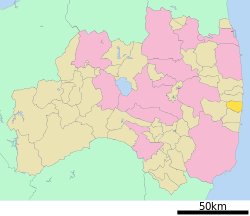Tomioka, Fukushima
| Tomioka 富岡町 | |||
|---|---|---|---|
| Town | |||
|
Tomioka Town Hall | |||
| |||
 Location of Tomioka in Fukushima Prefecture | |||
 Tomioka
| |||
| Coordinates: 37°19′59″N 141°01′01″E / 37.33306°N 141.01694°ECoordinates: 37°19′59″N 141°01′01″E / 37.33306°N 141.01694°E | |||
| Country | Japan | ||
| Region | Tōhoku | ||
| Prefecture | Fukushima | ||
| District | Futaba | ||
| Government | |||
| • -Mayor | Katsuya Endou | ||
| Area | |||
| • Total | 68.47 km2 (26.44 sq mi) | ||
| Population (October 2016) | |||
| • Total | 0 | ||
| • Density | 0/km2 (0/sq mi) | ||
| Time zone | Japan Standard Time (UTC+9) | ||
| - Tree | Sakura | ||
| - Flower | Azalea | ||
| - Bird | Motacillidae | ||
| Phone number | 0120-33-6466 | ||
| Address | Motooka Otsuka 622-1, Tomioka-machi, Futaba-gun, Fukushima-ken 979-1192 | ||
| Website | Official website | ||
Tomioka (富岡町 Tomioka-machi) is a town located in Futaba District, Fukushima Prefecture, Japan. As of 31 January 2011, the town had an estimated population of 15,839, with 6,293 families.[1]
As of December 2014, the town had an official registered population of 14,141 and a population density of 207 persons per km². The total area was 68.47 square kilometres (26.44 sq mi).[2]
Geography
Tomioka is located on the Pacific Ocean coastline of central Fukushima. It is the location for the Fukushima Daiichi Nuclear Power Plant, owned by the Tokyo Electric Power Company.
The town of Tomioka is divided into two main districts, each with their own train station. To the south is Tomioka, which is the main area. To the north, on top of the hill, is Yonomori, a smaller and much newer neighborhood. Though the two areas operate under one government, physical distance makes them feel like two separate towns.
Surrounding municipalities
History
The area of present-day Tomioka was part of Mutsu Province. The remains of Kofun period burial mounds have been found in the area. During the Edo period, it was originally part of Iwakitaira Domain, but from 1747 was divided between Tanagura Domain, Tako Domain and tenryo territory directly under the Tokugawa shogunate. After the Meiji restoration, on April 1, 1889, the village of Tomioka was created within Naraha District, Fukushima, which subsequently became Futaba District in April 1896. Tomioka was raised to town status on March 1, 1900. It merged with the neighboring town of Futaba on March 31, 1955.
2011 Tōhoku earthquake and tsunami
Tomioka was severely affected by the Fukushima Daiichi nuclear disaster, and the 2011 Tōhoku earthquake and tsunami on March 11, 2011. Besides sustaining considerable damage from the earthquake, and the tsunami (which devastated the coastal area), the town was evacuated en masse on the morning of March 12 as it is located well within the 20 kilometer exclusion radius around the damaged Fukushima Daiichi nuclear power plant. Only one man, 56–57-year-old fifth-generation rice farmer Naoto Matsumura, with his dog, refused to evacuate, and remained behind to feed the pets and livestock left behind in his neighborhood with supplies donated by support groups.[3][4][5]
On March 25, 2013, the nuclear evacuation zone in Tomioka was lifted by the central government, and the town was re-zoned into three areas according to different levels of radiation. However, the town government elected to keep the evacuation in place for at least another four years due to the need to rebuild damaged infrastructure. In the zone with the highest radiation levels residents will not be allowed to return home at least for five years. People other than registered residents are banned from entry. This zone, which covers the northeastern part of the town, had about 4,500 people residents. The central part of the town, which used to have 10,000 residents was designated as a residence restriction zone, in which the residents could return during daytime hours but have to leave at night. The remaining zone, which mainly covers southern Tomioka had about 1,500 residents, and remaining restrictions are expected to be lifted.[6]
However, in a survey taken in 2013, some 40 percent of the town’s residents responded that they had decided never to return, and 43 percent were undecided. Concerns over radiation exposure, and the loss of compensation money from TEPCO should they decide to return, coupled with uncertainty over whether or not they could make a living in Tomioka were major issues.[7]
Economy
The economy of Tomioka was formerly heavily dependent on commercial fishing and agriculture.
Education
High schools
Tomioka, Fukushima Prefectural HighSchool (founded in 1950) was the only high school in the town.[8]
Junior high schools
There were two junior high schools in Tomioka - Tomioka 1st Junior High School and Tomioka 2nd Junior High School.
Elementary schools
There were two elementary schools in Tomioka - Tomioka 1st Elementary School and Tomioka 2nd Elementary School.
Transportation
Railway
Highway
- Jōban Expressway – Tomioka IC
- Japan National Route 6
Local attractions
Fukushima Daini Nuclear Power Plant
The Fukushima Daini Nuclear Power Plant is a nuclear power plant located on a 1,500,000-square-metre (370-acre) site straddling Tomioka and Naraha, run by the Tokyo Electric Power Company (TEPCO). After the 2011 Tōhoku earthquake and tsunami, the four reactors automatically shut down and the plant remains offline.[9]
Hayama shrine
The main Shinto shrine in Tomioka is Hayama shrine where a fire festival was held to pray for a good harvest. The shrine is known as "Number 33, the thirty-third shrine in a pilgrimage path which goes across the country.
Tomioka government office complex
This complex consisted of three buildings connected by walkways and a mini park. The center building was home to the city government offices. On the left side of the complex is a building that used to house a large auditorium and the city's public library. The right side of the complex featured a small health center. The whole complex is located just north of where the Joban train line crosses Route 6 and is across the highway from the Tomioka Sports Center.
Yonomori Park
This park was very popular in spring when the cherry blossoms are blooming. Many locals came to view the blossoms and enjoy the festival atmosphere. During the Cherry Blossom Festival, there were many food, trinket, and game stalls. The town is famous for having one of the longest cherry blossom tunnels in Japan.
Tomioka Sports Center
Located between Route 6 and the ocean, this sports center contained multiple tennis courts and a baseball field, among other attractions. The facilities could be rented by the hour for a very reasonable price. Some local sports clubs met here.
Refre
Located at the intersection of the two roads with cherry blossom tunnels, Refre (リフレ) was a popular meeting place. Its facilities include a conference room with seating and catering for hundreds of people, a hotel, a fitness center, a hot spring, one indoor heated pool for lap swimming, and one indoor/outdoor pool for general use, though the second pool is closed during the winter months.
Tomioka Beach
During the summer months leading up to Obon, a beach was open for public swimming. After Obon, however, the beach was closed due to the large population of jellyfish. The beach is a short distance from Tomioka station.
International relations
 New Zealand – Auckland, New Zealand, friendship city since December 6, 1983
New Zealand – Auckland, New Zealand, friendship city since December 6, 1983 China – Haiyan County, Zhejiang, friendship city since June 20, 1995
China – Haiyan County, Zhejiang, friendship city since June 20, 1995
References
- ↑ "Welcome to Tomioka" (in Japanese). Japan: Tomioka Town. Retrieved 11 March 2012.
- ↑ "Home Page" (in Japanese). Tomioka Town. Retrieved 6 February 2015.
- ↑ Lah, Kyung (27 January 2012). "Resident defiant in Japan's exclusion zone". CNN. Retrieved 29 March 2012.
- ↑ "Lone farmer in no-go zone sticks to defiant existence". The Japan Times. 6 April 2012. Retrieved 6 April 2012.
- ↑ Kosuga, Tomo (11 March 2013). "Radioactive Man". Vice. Retrieved 14 March 2013.
- ↑ "Nuclear evacuation zone revised in Fukushima’s Tomioka", the Japan Times, March 26, 2013.
- ↑ Kageyama, Yuri "Fukushima residents unsure of return to no-go zone", Yahoo news, April 30, 2014.
- ↑ 富岡高等学校について (in Japanese). Tomioka, Fukushima Prefectural High School. Retrieved 14 March 2013.
- ↑ "Japan initiates emergency protocol after earthquake". Nuclear Engineering International. 11 March 2011. Retrieved 11 March 2012.
External links
| Wikimedia Commons has media related to Tomioka, Fukushima. |
- Official website (Japanese)
- Live web camera in Tomioka Looking South along Rikuzenhama Highway (National Route 6) at the intersection of Fukushima Prefectural road 163 (Japanese)
- Documentary of Naoto Matsumura and Kenji Hasegawa living solo in the Fukushima evacuation zone
- Photo essay from Tomioka and Futaba by Arkadiusz Podniesiński
